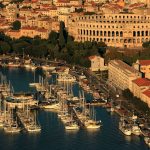Remnants of sunk naval ships in Pula port are now preventing cruise ships from docking safely.
The waters of Pula port are currently home to 3000 tonnes of steel and iron. As it used to be the largest Navy port on the Adriatic, the seabed is covered with parts of Austro-Hungarian ships from the Uljanik shipyard, as well as debris from sunk naval ships such as the legendary Viribus Unitis, once the largest ship in the Austro-Hungarian Navy fleet. One can also find enormous anchor blocks, sunk fishing boats, as well as ancient mines and bombs.
What resembles a proper museum of Pula’s history presents a large problem for the port, as all the debris and waste interfere with large passenger ships as they enter or exit the port waters, reports Jutarnji on September 26, 2017.
Florian Veneruzzo of the Port Authority Pula told the reporters about one such case that happened six or seven years ago. “A large cruise ship docked in the port and waited for the passengers to return. However, when it tried to sail out, it ran into a problem. The ship’s anchor caught on something at the bottom of the sea, and the crew wasn’t able to release it. We called a diving team to help, as it turned out the anchor was caught on a large anchor block dating back to Austro-Hungarian era”, said Veneruzzo. It wasn’t the only case of this kind.
The anchor blocks weigh around 7-8 tonnes and measure two metres in height and width. They are fixed to the seabed with tri giant anchors each; naval ships used them to dock back in the day. Nowadays, it’s only large cruise ships that accidentally “dock” at the blocks, as it’s been 100 years and the historical remnants still haven’t been removed.
The Port Authority negotiated with multiple companies that could clean up the sea bottom, but the initiative turned out to be too expensive. As it would call for an investment of 10 million euro, the project has been postponed until the port signs off on a large construction project for a new passenger terminal that will be worth around 1 billion kuna. An investor from Venice, Venezia terminal Passeggeri, is allegedly interested.
“We’ve been contacted by a couple of companies who offered to remove all the iron from the port free of charge, under the condition they keep all the material. Conservators opposed such a solution, as they instructed for each anchor to be cleaned and preserved. We left it at that, as it would be a major expense reaching millions of euro. It would also call for a whole team of people, and it probably wouldn’t be finished in a month, but in a couple of years. There’s always an administrative obstacle as to why something can’t be done, and a port is like a road. It’s not a romantic place, but a place for transport of cargo and people”, said Veneruzzo.
Raul Marsetič, historian at the Centre for Historical Research in Rovinj, stated the Austro-Hungarian navy base’s infrastructure was flawless. As large naval ships couldn’t dock at the pier, anchor blocks and floating docks were installed in the port as an alternative; they enabled the ships to moor in two rows.
The most fascinating remnant of an era gone by is the mentioned Viribus Unitis, the fleet’s largest naval ship that was sunk on November 1, 1918. After the World War I had ended, Croatia got ownership of Viribus Unitis and the rest of the fleet; it was sunk soon thereafter in an action called Pula Raid (Prepad na Pulu) carried out by Italian commandos who later got dubbed Italian national heroes.
Conservators tried to preserve what was left of the ship on multiple occasion. One part was raised from the sea back when Istria was ruled by Italy; the main anchor and a fraction of the prow ended up in a museum in Venice. As it was decided against raising the entire ship, it was mined in the 20s so fragments could be raised one by one. According to Kruno Zubčić, an archaeologist at the Croatian Conservation Institute, the research project will continue, and the city will soon mark the 100th anniversary of the ship’s sinking.








